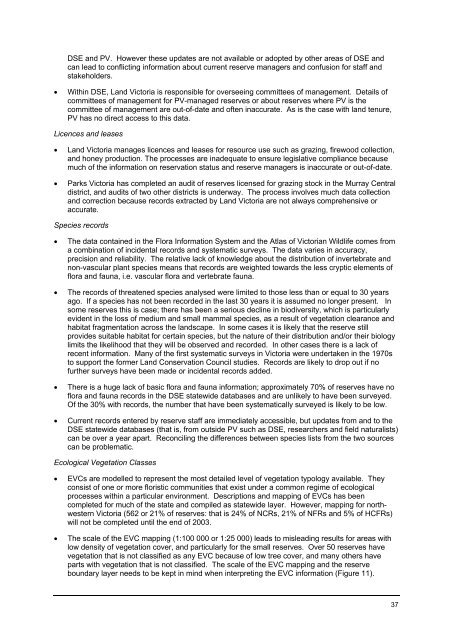Conservation Reserves Management Strategy 2003 - Parks Victoria
Conservation Reserves Management Strategy 2003 - Parks Victoria
Conservation Reserves Management Strategy 2003 - Parks Victoria
Create successful ePaper yourself
Turn your PDF publications into a flip-book with our unique Google optimized e-Paper software.
DSE and PV. However these updates are not available or adopted by other areas of DSE andcan lead to conflicting information about current reserve managers and confusion for staff andstakeholders.• Within DSE, Land <strong>Victoria</strong> is responsible for overseeing committees of management. Details ofcommittees of management for PV-managed reserves or about reserves where PV is thecommittee of management are out-of-date and often inaccurate. As is the case with land tenure,PV has no direct access to this data.Licences and leases• Land <strong>Victoria</strong> manages licences and leases for resource use such as grazing, firewood collection,and honey production. The processes are inadequate to ensure legislative compliance becausemuch of the information on reservation status and reserve managers is inaccurate or out-of-date.• <strong>Parks</strong> <strong>Victoria</strong> has completed an audit of reserves licensed for grazing stock in the Murray Centraldistrict, and audits of two other districts is underway. The process involves much data collectionand correction because records extracted by Land <strong>Victoria</strong> are not always comprehensive oraccurate.Species records• The data contained in the Flora Information System and the Atlas of <strong>Victoria</strong>n Wildlife comes froma combination of incidental records and systematic surveys. The data varies in accuracy,precision and reliability. The relative lack of knowledge about the distribution of invertebrate andnon-vascular plant species means that records are weighted towards the less cryptic elements offlora and fauna, i.e. vascular flora and vertebrate fauna.• The records of threatened species analysed were limited to those less than or equal to 30 yearsago. If a species has not been recorded in the last 30 years it is assumed no longer present. Insome reserves this is case; there has been a serious decline in biodiversity, which is particularlyevident in the loss of medium and small mammal species, as a result of vegetation clearance andhabitat fragmentation across the landscape. In some cases it is likely that the reserve stillprovides suitable habitat for certain species, but the nature of their distribution and/or their biologylimits the likelihood that they will be observed and recorded. In other cases there is a lack ofrecent information. Many of the first systematic surveys in <strong>Victoria</strong> were undertaken in the 1970sto support the former Land <strong>Conservation</strong> Council studies. Records are likely to drop out if nofurther surveys have been made or incidental records added.• There is a huge lack of basic flora and fauna information; approximately 70% of reserves have noflora and fauna records in the DSE statewide databases and are unlikely to have been surveyed.Of the 30% with records, the number that have been systematically surveyed is likely to be low.• Current records entered by reserve staff are immediately accessible, but updates from and to theDSE statewide databases (that is, from outside PV such as DSE, researchers and field naturalists)can be over a year apart. Reconciling the differences between species lists from the two sourcescan be problematic.Ecological Vegetation Classes• EVCs are modelled to represent the most detailed level of vegetation typology available. Theyconsist of one or more floristic communities that exist under a common regime of ecologicalprocesses within a particular environment. Descriptions and mapping of EVCs has beencompleted for much of the state and compiled as statewide layer. However, mapping for northwestern<strong>Victoria</strong> (562 or 21% of reserves: that is 24% of NCRs, 21% of NFRs and 5% of HCFRs)will not be completed until the end of <strong>2003</strong>.• The scale of the EVC mapping (1:100 000 or 1:25 000) leads to misleading results for areas withlow density of vegetation cover, and particularly for the small reserves. Over 50 reserves havevegetation that is not classified as any EVC because of low tree cover, and many others haveparts with vegetation that is not classified. The scale of the EVC mapping and the reserveboundary layer needs to be kept in mind when interpreting the EVC information (Figure 11).37

















